These days, electronics are all around us. For the most part, this is a good thing. What would modern life be without our smartphones, tablets, and computers? But these same devices also produce electromagnetic radiation, which is a concern for some people.
For one thing, certain individuals are sensitive to radiation, and experience physical symptoms. If you’re one of those people, it makes sense to keep your devices from putting out more radiation than necessary. For another thing, wireless devices can be vulnerable hacking. If you’re walking around with your tablet or smartphone, hackers might be able to access your personal information. The same goes for anything with an RFID chip, like your credit card. If you’re concerned about people stealing your money or identity, EMF protection is a viable solution.
In the past, we’ve reviewed whole house EMF neutralizers. These are a bit different, meant to normalize fluctuation in your household voltage. Today, we’re going to look at Faraday fabric. This type of fabric is meant to block EMF radiation, so you can make pouches or otherwise shield your devices.
We’ll start out by reviewing the Atmosure Copper Faraday Fabric. This is a copper fabric that’s highly conductive and has a bright metallic sheen. Next, we’ll look at the TitanRF Faraday Fabric Kit. This is a more subdued copper and nickel blend, and includes a roll of EMF-resistant tape. Last but not least, we’ll examine the Amradield Faraday Fabric. This fabric incorporates polyester for better flexibility and a more sheer appearance. Which of these fabrics is going to be the best choice for your project? To find out, we’ll need to take a closer look at each of them individually. We’ll talk about how they’re made, what they’re made from, and how they can be used. We’ll also discuss their effectiveness. After that, we’ll be better prepared to render judgement. Let’s get started!
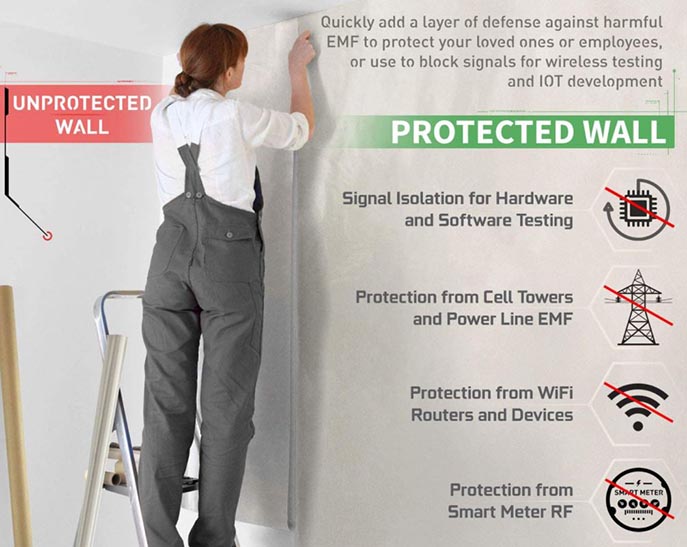
What is Faraday Fabric?
Before we discuss these three Faraday fabrics, let’s talk about how they work to begin with. Faraday fabrics are based on the principle of the Faraday cage, which is an all-purpose electromagnetic shield. It was first invented by 19th-century inventor Michael Faraday. The initial intention was to protect against electricity, which was a new fangled concept at the time. However, electricity is just one form of electromagnetic radiation. EM radiation also includes microwaves, X-rays, ultraviolet light, radio waves, and even visible light. Depending on how a cage is designed, it can block different types of radiation.
Early Faraday cages were exactly what they sounded like – cages. By using conductive material in the correct pattern, Faraday was able to create an electricity-proof enclosure. These types of large cages are still used today. For example, vehicle frames are designed to function as Faraday cages. If your car is struck by lightning, the lightning passes harmlessly through the frame and into the ground. If Faraday cages didn’t work, driving would be considerably more hazardous! Many buildings, such as hospitals and military facilities, are also engineered with Faraday cages built into the design.
Here’s how it works. A charged object (such as a power cord or a stream of charged particles), approaches the Faraday cage. Instead of passing through, charged particles are attracted to the conductive material, and travel around the outside. Negatively charged particles flow through one side, while positively charged particles flow the other way. This phenomenon is called electrostatic induction. It’s how wireless chargers and induction stoves work! Inside the Faraday cage, the opposing electric charges on both sides cancel each other out. Inside the mesh, the net electric charge will be zero.
This is a lot of talk about electricity. But what in the world does that have to do with electromagnetic radiation? The answer is in the nature of the opposing electric field. Even in the presence of an exterior static charge, everything inside remains shielded. Depending on the design of the cage, that electric charge will then block different types of radiation. This is their main benefit, and it’s the reason most people use them. That said, it’s important to understand how they work if you want to get the most out of them.
For one thing, Faraday cages work best when they fully enclose an object. If you put a cage only on one side, the object is only going to be partially shielded. This would be analogous to going to the beach, but only putting sunscreen on one side of your body. The other thing is that different cages will have different levels of effectiveness. In order to function, Faraday fabrics need to be flexible. If they’re totally rigid, you might as well buy pre-assembled panels. However, this limits the amount of conductive material that can be woven into any single layer of material.
Faraday cages and fabrics can go by a number of different names. They’re sometimes advertised as Faraday shields, EMF fabrics, and RF shields. You can even purchase pre-made EMF-blocking patches and pouches. These have the advantage of already being premade, but you can’t customize them. And with the patches, remember that you’re only blocking one side.
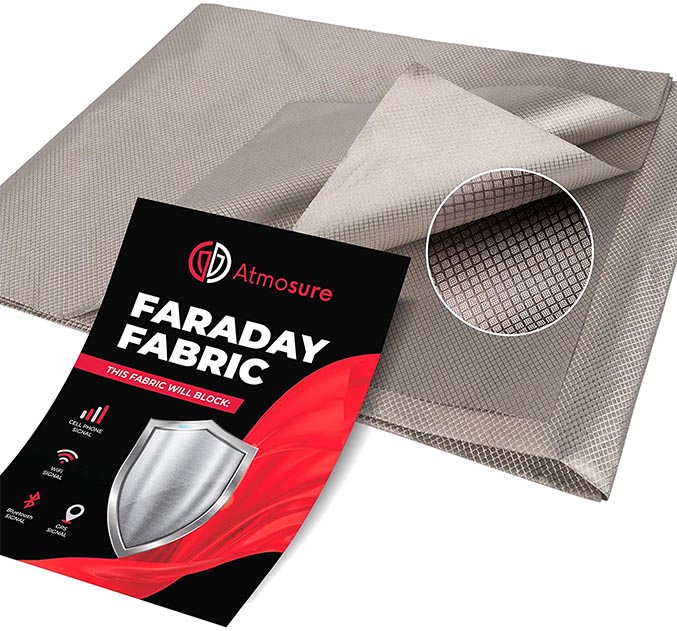
Atmosure Copper Faraday Fabric
The Atmosure Copper Faraday Fabric is the most obviously metallic fabric on our list. It’s made from copper, and has the corresponding gold-brown copper color. When you look up close, it has a fine diamond pattern. This is a nice aesthetic touch, and it’s certainly easy on the eyes. However, it’s also part of the function of the material. Remember what we said about Faraday cages arranging metal in a pattern? In the Atmosure fabric’s case, that pattern is diamond-shaped. Regardless, it’s very eye-catching, and glistens when you shine a light on it. It would be a fun fashion statement, although it’s certainly more expensive than most clothing fabric.
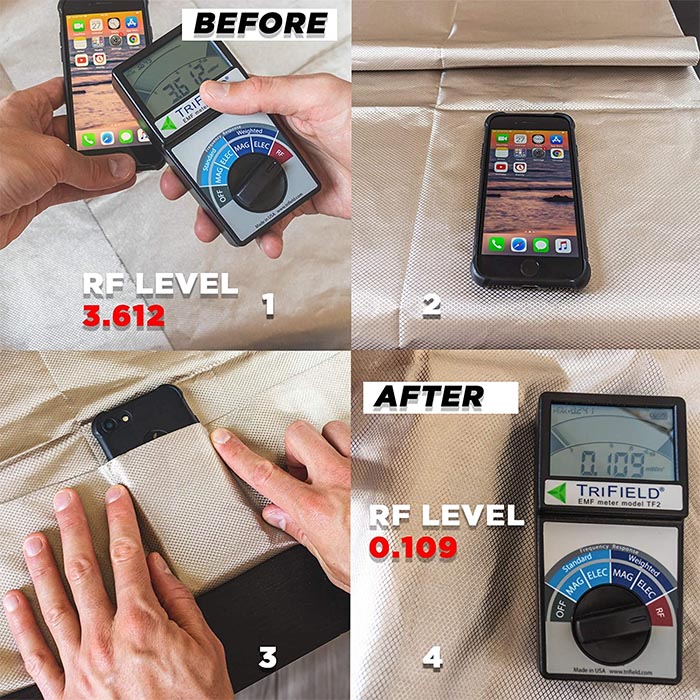
As you might expect, the Atmosure fabric is sold by the yard. In this case, the bolt width is 44 inches, so a yard measures 44 by 36 inches in size. That’s enough to make a case for a tablet or laptop, with a bit left over to spare. As with any other fabric, keep in mind that it’s only hemmed along the sides of the bolt. When a yard is cut off, there’s no further finishing done to the material. As a result, when you receive the fabric, it will not be hemmed along the short edges. To use it all the way up to the edge, you’ll need to hem those edges before you start. Otherwise, the fabric will eventually start to unravel.
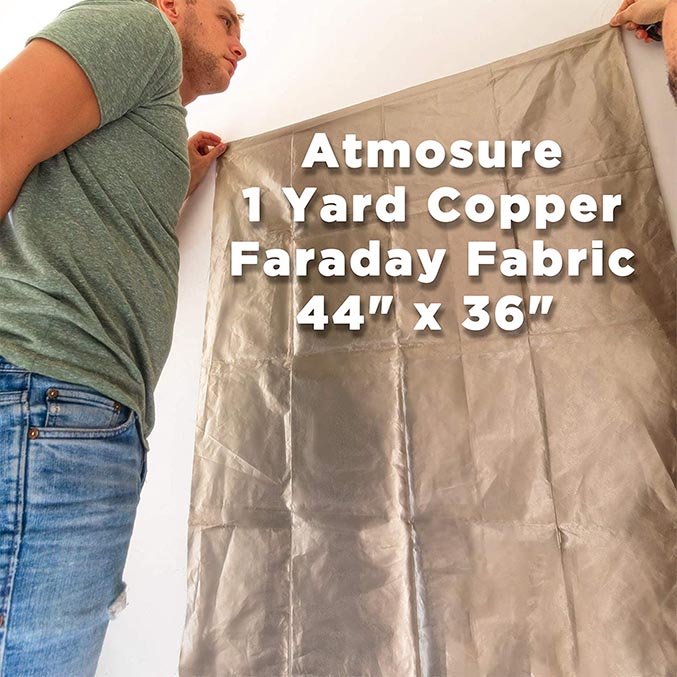
This is a beautiful cloth to look at, but is it functional? It depends on your expectations. The main thing people use this kind of cloth for is smartphones, so that’s how we’ll be judging them. A single layer of the material is sufficient to drop cell performance by about two bars. Whether or not that will be sufficient will depend on what you need. If you live in a rural environment, a single layer will most likely be enough to eliminate your signal completely. If you’re in an area with denser coverage, you’ll need to double the fabric up for better results.
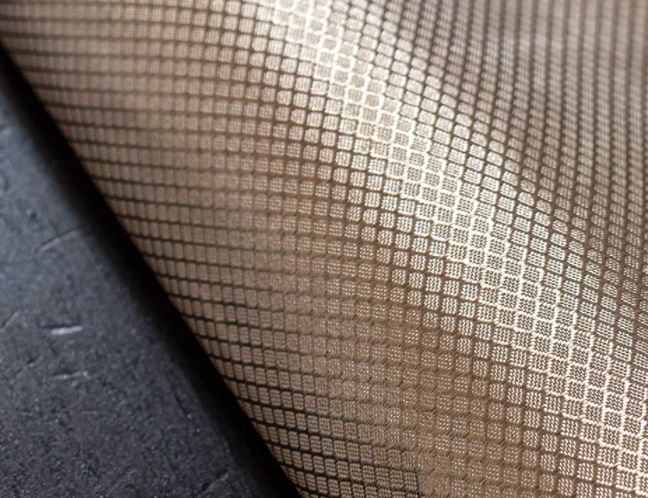
This will affect how you use the Atmosure cloth. Are you just trying to protect your credit cards inside your purse? A single-layer liner should be more than sufficient. Are you trying to make your own EMF-proof laptop case? In that case, you may want to double or even triple the material. It depends on what you’re trying to achieve as much as anything else. One thing to keep in mind with most Faraday fabrics is that they’re conductive enough to get hot. Avoid using this fabric directly next to power strips and outlets.
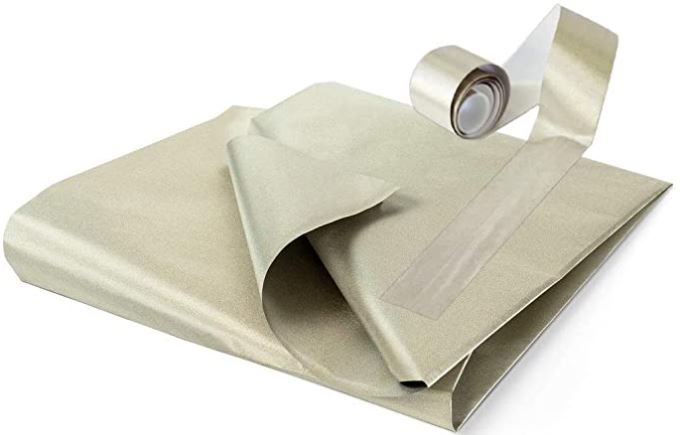
TitanRF Faraday Fabric Kit
The TitanRF Faraday Fabric Kit consists primarily of one yard of a tan-colored material. Like the Atmosure cloth, this cloth measures 44 inches in width and 36 inches long. Also like the Atmosure cloth, it’s not hemmed on the short ends. You’ll need to hem it off if you’re trying to use the entire piece. Because it’s made from a copper and nickel blend, the color of this fabric is considerably more subdued. This makes it more suitable for constructing custom pouches, or even for lining your walls. It’s not going to attract a ton of attention. That said, there’s also no texture or pattern. This gave us some concerns about its potential effectiveness.
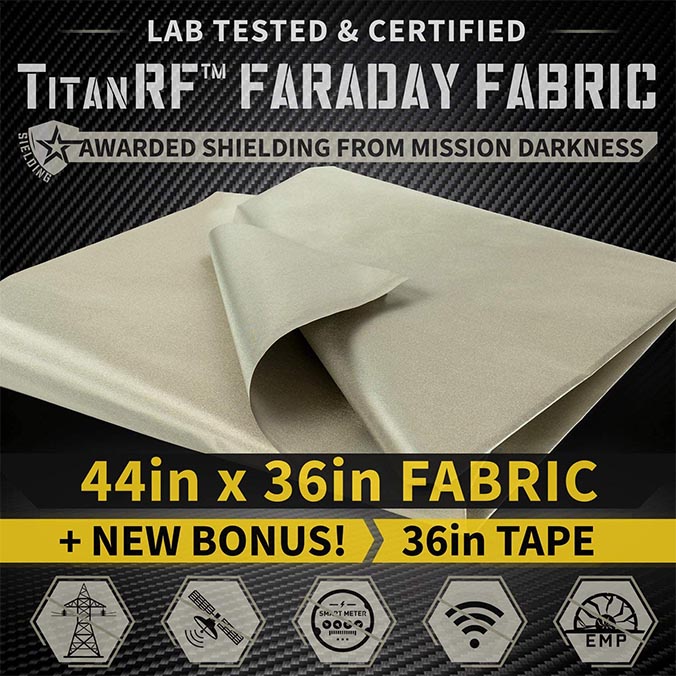
As you may have gathered from the name, this isn’t just a standalone yard of fabric. It’s also a roll of electrostatic tape. TitanRF did a good job of matching the color to the material, so you’ll barely notice it’s there. Still, the tape is best used on the inside of a pouch than on a visible area. It’s not literally invisible. It’s just a nice way to be able to use your fabric without using a sewing machine. Fold the fabric into the shape you want, tape down any flaps, and you’re ready to go.
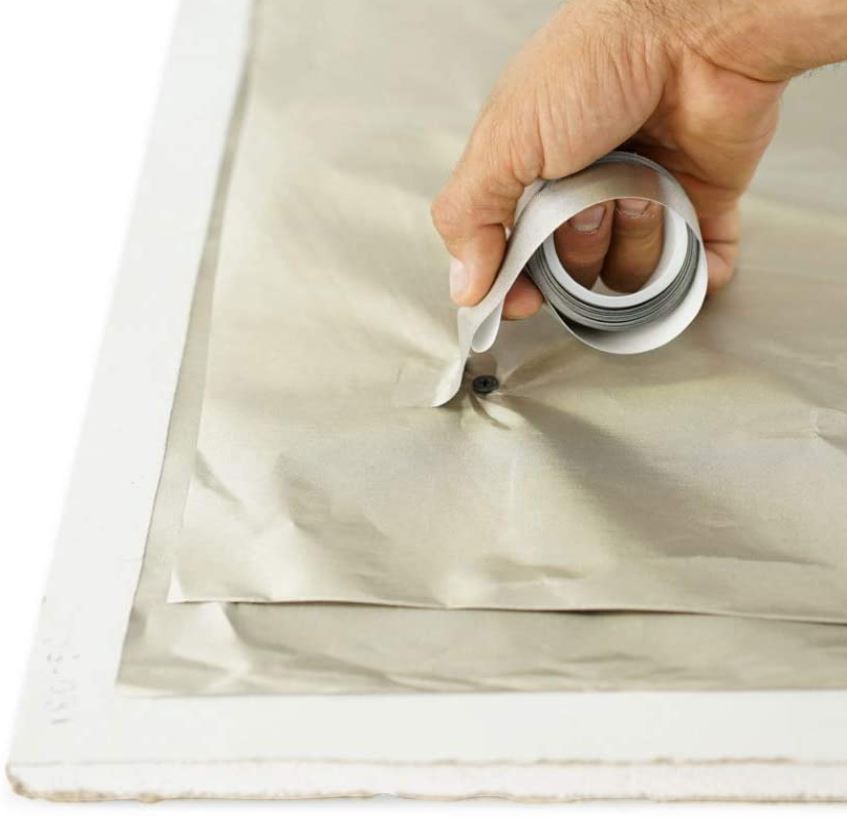
As far as effectiveness goes, the TitanRF fabric isn’t as effective as the Atmosure fabric. It does a decent job blocking Bluetooth signals, but anything else is just too powerful. You can double or triple the material, which TitanRF actually recommends doing. If you look at their instructions for making your own pouch, the fabric is doubled over, and tripled in places. This is more or less standard for any Faraday fabric. But even so, you’re not going to completely block out a cell phone signal under most scenarios. It will work in rural areas, and that’s about it. That said, this less-conductive material does have its benefits. You can use it closer to power outlets than you can with a more conductive fabric.
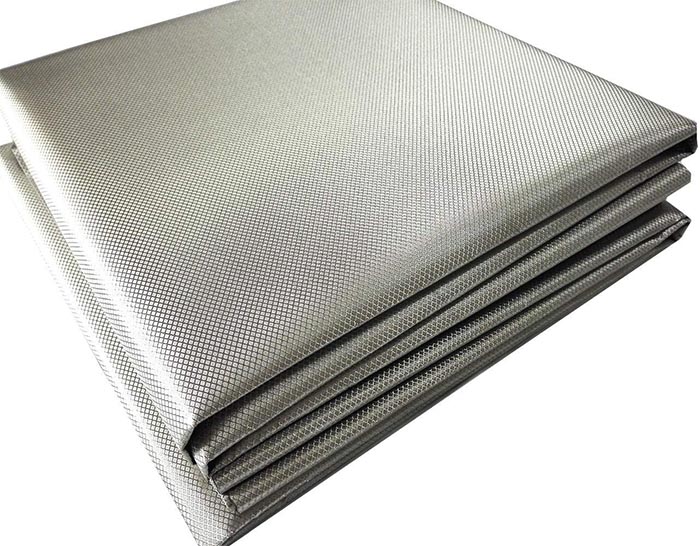
Amradield Faraday Fabric
The Amradield Faraday Fabric is a unique blend of copper, nickel, and polyester. The polyester gives it plenty of flexibility, with the metallic threads stitched into a diamond pattern. It’s silver in color, although it has a dull finish that’s minimally reflective. In fact, it’s actually semi-sheer. Under certain conditions, you can actually see through the material. This can be a good thing or a bad thing depending on what you’re doing. It’s great for liners, or if you’re doubling up. As a standalone material, we’d avoid using a single layer for most purposes.
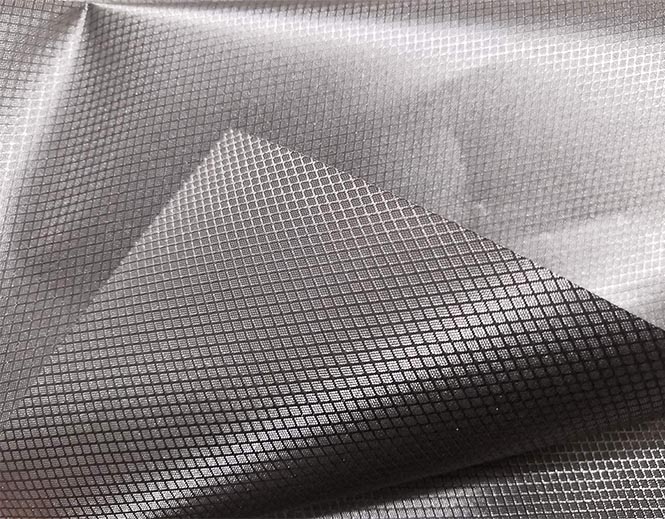
This cloth is sold in multiple lengths, with a 43-inch width. You can even order 50-meter bolts for massive projects. Other lengths are also in meters, but correspond to 39, 78, and 197 inches. It’s also highly conductive. You want to keep it well clear of power outlets and surge protectors. The upside is that it’s reasonably effective. You’ll need to double it up for most applications. But a single layer will block most Bluetooth devices all by itself. Depending on what you need, that may be more than good enough.
Final Verdict
So, which of these EMF-blocking Faraday fabrics is going to be best for your needs? It depends mostly on appearance and effectiveness. In terms of both, the Atmosure Copper Faraday Fabric is a solid choice. It’s reasonably effective, at least as much as any fabric can be. Not only that, but the bright copper appearance looks great as a bag liner. On the other hand, it’s a bit flashy for a standalone bag or pouch. If you want a low-key material that doesn’t attract attention, this ain’t it.
The TitanRF Faraday Fabric Kit has the least-conductive material of the bunch. By definition, this makes it the least effective. However, it’s the easiest to use if you’re trying to make your own pouch. It also comes with electrostatic tape, so you don’t have to be a sewing expert to start your project.
The Amradield Faraday Fabric falls in the middle of the pack in terms of effectiveness. It’s reasonably effective when doubled up, but not very practical as a single layer. However, it’s the most pliable of these materials by far, with polyester as well as metallic threads. If you want a fabric that’s easy to work with, it’s an excellent choice.
Meet Ry, “TechGuru,” a 36-year-old technology enthusiast with a deep passion for tech innovations. With extensive experience, he specializes in gaming hardware and software, and has expertise in gadgets, custom PCs, and audio.
Besides writing about tech and reviewing new products, he enjoys traveling, hiking, and photography. Committed to keeping up with the latest industry trends, he aims to guide readers in making informed tech decisions.


Hi, which would be a good fabric to make curtains , clothes and canopy
Any of these options would be appropriate for making curtains, clothes or a bed canopy.